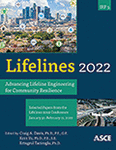Recommendations toward Functional Recovery Performance of Lifeline Infrastructure Systems
Publication: Lifelines 2022
ABSTRACT
In response to a Congressional mandate to recommend “options for improving the built environment and critical infrastructure to reflect performance goals stated in terms of post-earthquake re-occupancy and functional recovery time,” the National Institute of Standards and Technology and Federal Emergency Management Agency have initiated efforts to address the functional recovery performance of buildings and lifeline infrastructure systems. This paper focuses on recommendations for lifeline systems, emphasizing the need to: (i) establish a consistent national performance framework across all lifelines to enable consistent functional recovery objectives; (ii) provide national guidance on regulatory authorities to enable consistent implementation; (iii) evaluate existing lifeline infrastructure to assess expected performance and identify and prioritize upgrades; (iv) develop national standards for orderly recovery at component, system, and system-of-systems levels; (v) create regional councils to identify lifeline interdependencies and manage agency coordination; and (vi) enable recovery through planning, education, and financial resources.
Get full access to this article
View all available purchase options and get full access to this chapter.
REFERENCES
AASHTO. 2011. LRFD Seismic Bridge Design, 2nd Ed., with 2012, 2014, 2015 Interim Rev., American Association of State and Highway Transportation Officials, Washington, D.C.
Arendt, L., and Alesch, D. 2014. Long-term Community Recovery from Natural Disasters, CRC Press, Boca Raton, Florida.
ASCE. 2014. Seismic Design of Piers and Wharves, ASCE/COPRI Standard 61-14, American Society of Civil Engineers, Reston, VA.
ASCE. 2017. 2017 Report Card for America’s Infrastructure, American Society of Civil Engineers, https://www.infrastructurereportcard.org/americas-grades/, accessed 3/26/20.
AWWA. 2011. Welded Carbon Steel Tanks for Water Storage, ANSI/AWWA D100-11, American Water Works Association, Denver, Colorado.
CPUS (California Public utilities Commission). 2021. Public Safety Power Shutoff (PSPS)/De-Energization, https://www.cpuc.ca.gov/psps/, accessed June 12,2021.
Caltrans. 2019. Caltrans Seismic Design Criteria, Version 2.0 (SDC 2.0), California Department of Transportation, Sacramento, California.
Davis, C. A. 2018. “Creating a Seismic Resilient Pipe Network for Los Angeles,” ASCE Pipelines 2018, UESI, paper 384423, Toronto, CN, July 2018.
FEMA. 1991a. Collocation Impacts on the Vulnerability of Lifelines During Earthquakes with Applications to the Cajon Pass, California, FEMA 221, Earthquake Hazard Reduction Series 59, Federal Emergency Management Agency, Washington, D.C.
FEMA. 1991b. Seismic Vulnerability and Impact of Disruption of Lifelines in the Conterminous United States, FEMA 224, prepared by the Applied Technology Council for the Federal Emergency Management Agency, Washington, D.C.
FEMA-NIST. 2021. Recommended Options for Improving the Built Environment for Post-Earthquake Reoccupancy and Functional Recovery Time, FEMA P-2090/NIST SP-1254, https://nvlpubs.nist.gov/nistpubs/SpecialPublications/NIST.SP.1254.pdf.
FHWA. 2017. “Replacing Oakland’s Cypress Freeway,” Federal Highway Administration, U.S. Department of Transportation, accessed April 21, 2020, https://www.fhwa.dot.gov/publications/publicroads/98marapr/cypress.
Hudnut, K. W., Wein, A. M., Cox, D. A., Porter, K. A., Johnson, L. A., Perry, S. C., Bruce, J. L., and LaPointe, D. 2018. The HayWired Earthquake Scenario – We Can Outsmart Disaster, https://doi.org/10.3133/fs20183016.
IEEE. 2018. Recommended Practice for Seismic Design of Substations, IEEE Standard 693, Institute of Electrical and Electronics Engineers, Piscataway, New Jersey.
Liu, X., Shahidehpour, M., Li, Z., Liu, X., Cao, Y., and Bie, Z. “Microgrids for Enhancing the Power Grid Resilience in Extreme Conditions,” in IEEE Transactions on Smart Grid, vol. 8, no. 2, pp. 589–597, March 2017.
NIST. 2014. Earthquake Resilient Lifelines: NEHRP Research, Development, and Implementation Roadmap, NIST GCR 14-917-33, prepared by the Applied Technology Council for the National Institute of Standards and Technology, Gaithersburg, Maryland.
NIST. 2016c. Critical Assessment of Lifeline System Performance: Understanding Societal Needs in Disaster Recovery, NIST GCR 16-917-39, prepared by the Applied Technology Council for the National Institute of Standards and Technology, Gaithersburg, Maryland.
O’Rourke, T. D. 2007. “Critical Infrastructure, Interdependencies, and Resilience,” The Bridge, Vol. 37, No. 1, https://www.nae.edu/File.aspx?id=7405.
Petersen, M. D., et al. 2014. Documentation for the 2014 Update of the US National Seismic Hazard Maps, https://pubs.usgs.gov/of/2014/1091/pdf/ofr2014-1091.pdf.
RRMC (Risk and Resilience Measurement Committee). 2019. Resilience-Based Performance: Next Generation Guidelines for Buildings and Lifeline Standards, ASCE Infrastructure Resilience Division, IRP3, American Society of Civil Engineers, Reston, Virginia.
Sattar, S., Mahoney, M., Kersting, R., Heintz, J., Johnson, K., Arendt, L., and Davis, C. 2020. “Recommended Options for Improving the Functional Recovery of the Built Environment and Critical Infrastructure,” 17th World Conference on Earthquake Engineering, Sendai, Japan, Paper No. C002378.
Telcordia. 2017. “NEBS Requirements: Physical Protection,”, Issue 5, Telcordia Technologies.
Information & Authors
Information
Published In
History
Published online: Nov 16, 2022
Authors
Metrics & Citations
Metrics
Citations
Download citation
If you have the appropriate software installed, you can download article citation data to the citation manager of your choice. Simply select your manager software from the list below and click Download.
